AI Summary
Ever had a customer claim they never received their order confirmation email? Without a WooCommerce email log, you’re left guessing whether the email was sent, blocked, or lost in spam.
When customers don’t receive their order confirmations or password reset emails, it creates support headaches and damages trust. The problem is, WordPress doesn’t tell you if emails actually reached their destination.
With a WooCommerce email log, you can:
- Verify if order emails were sent successfully
- Resend failed customer notifications
- Troubleshoot delivery issues
- Provide proof of communication for disputes
In this guide, I’ll show you how to set up email logging for WooCommerce using WP Mail SMTP. You’ll be able to track every email, monitor delivery status, and resend any failed messages with just one click.
Fix Your WooCommerce Emails Now
How Do I Check Email Logs in WooCommerce?
It’s easy to test WooCommerce email deliverability and logs using WP Mail SMTP.
When you install WP Mail SMTP to configure WooCommerce SMTP email settings, it’ll keep track of every email sent out from your website.
After that, you’ll be able to:
- Resend WooCommerce order emails
- Forward WooCommerce emails to an alternative address
- See the delivery status of individual emails
- Print WooCommerce emails
- Resend password reset emails and resend account activation emails
- And a lot more.
Your email log could prove vital when providing customer service or resolving a dispute. Let’s get yours set up now.
How To Log Your WooCommerce Order Emails
- 1. Install WP Mail SMTP
- 2. View Your WooCommerce Email Log
- 3. Track and Resend WooCommerce Order Emails
- Next, Create a Newsletter For Your Customers
1. Install WP Mail SMTP
First, let’s install the WP Mail SMTP plugin on your website. You’ll need the Pro version to turn on email logging.
To download the plugin, go to your WP Mail SMTP account and switch to the Downloads tab. Download the latest version of the plugin file.
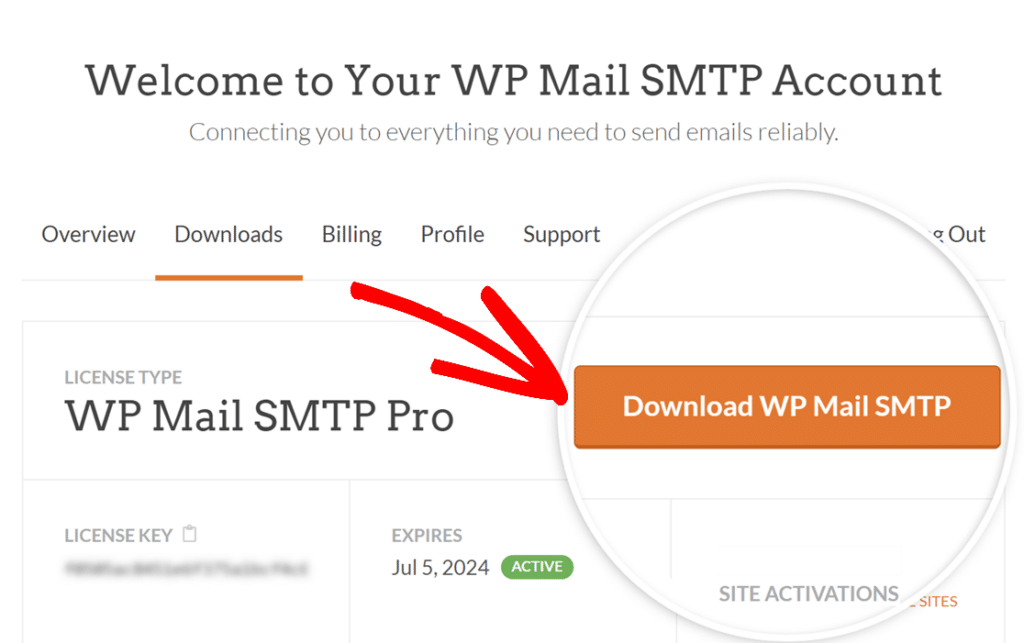
Next, log in to your WordPress dashboard. Here, you’ll want to upload the plugin and activate it.

When the plugin’s been activated you’ll see the Setup Wizard open in your browser.
If you need some more help installing WP Mail SMTP, check out this plugin installation guide.
Choose an Email Provider
When you send emails from WooCommerce, it sends them via your web server. In many cases, this results in the emails going to the customer’s spam folder.
So in this step, we’ll pick a new transactional email provider to handle your email. There are free and paid options here so you can pick the best fit for your site.
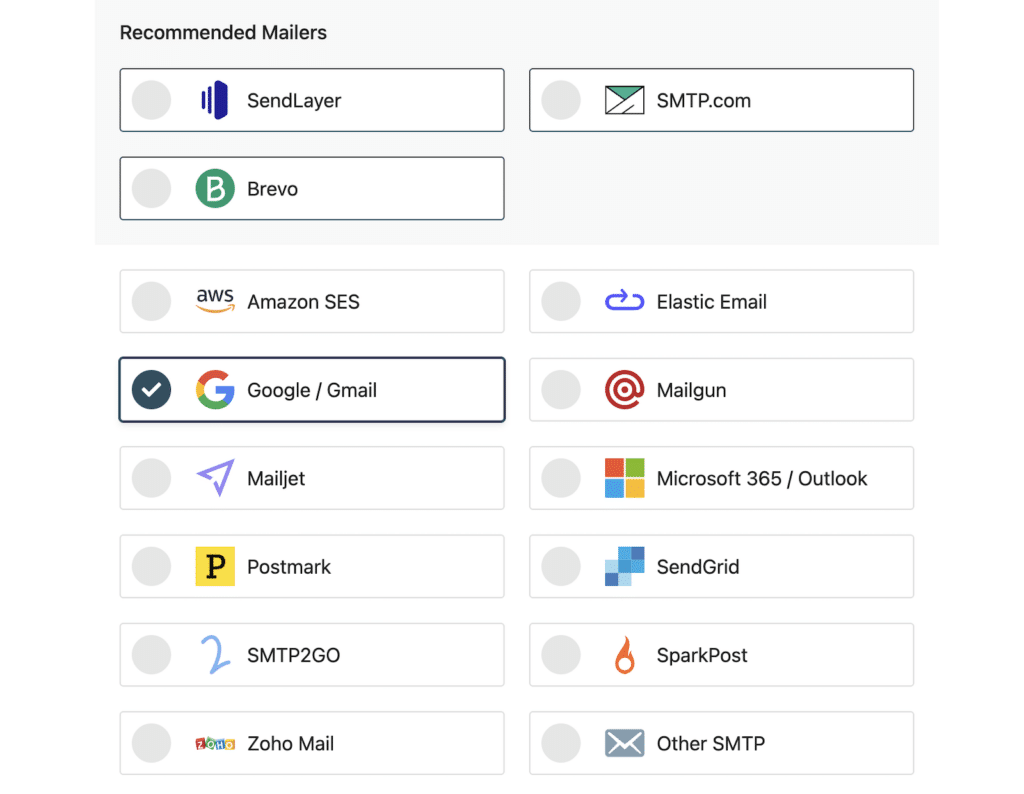
If you’re not sure what to pick, we recommend SendLayer, Brevo (formerly Sendinblue), or SMTP.com. These are all professional transactional email providers that are easy to configure in WordPress.
You can pick another provider if you prefer, including Other SMTP if you want to use an external SMTP server.
Ready to move on? Now we can set up the email provider and complete the connection to your WooCommerce site. We’ve got complete documentation for every email provider to make this easy. Click the link below to jump to the documentation for the email provider you chose:
- SendLayer
- SMTP.com
- Brevo
- Amazon SES
- Google Workspace / Gmail
- Mailgun
- Microsoft 365 / Outlook.com
- Postmark
- SendGrid
- SparkPost
- SMTP2GO
- Mailjet
- Elastic Email
- Zoho Mail
- Other SMTP
Need a hand?
Our Elite license includes White Glove Setup for SendLayer, SMTP.com, or Brevo.
Come back to this guide when you’re ready to move to the next step.
Enable WooCommerce Email Logging
In this step, we’ll enable email logging for WooCommerce. This setting will keep track of the email headers and the email delivery status and store it in your WordPress email log.
After you set up your mailer, you’ll see additional WP Mail SMTP features you can enable. Be sure to check the Detailed Email Log option here.
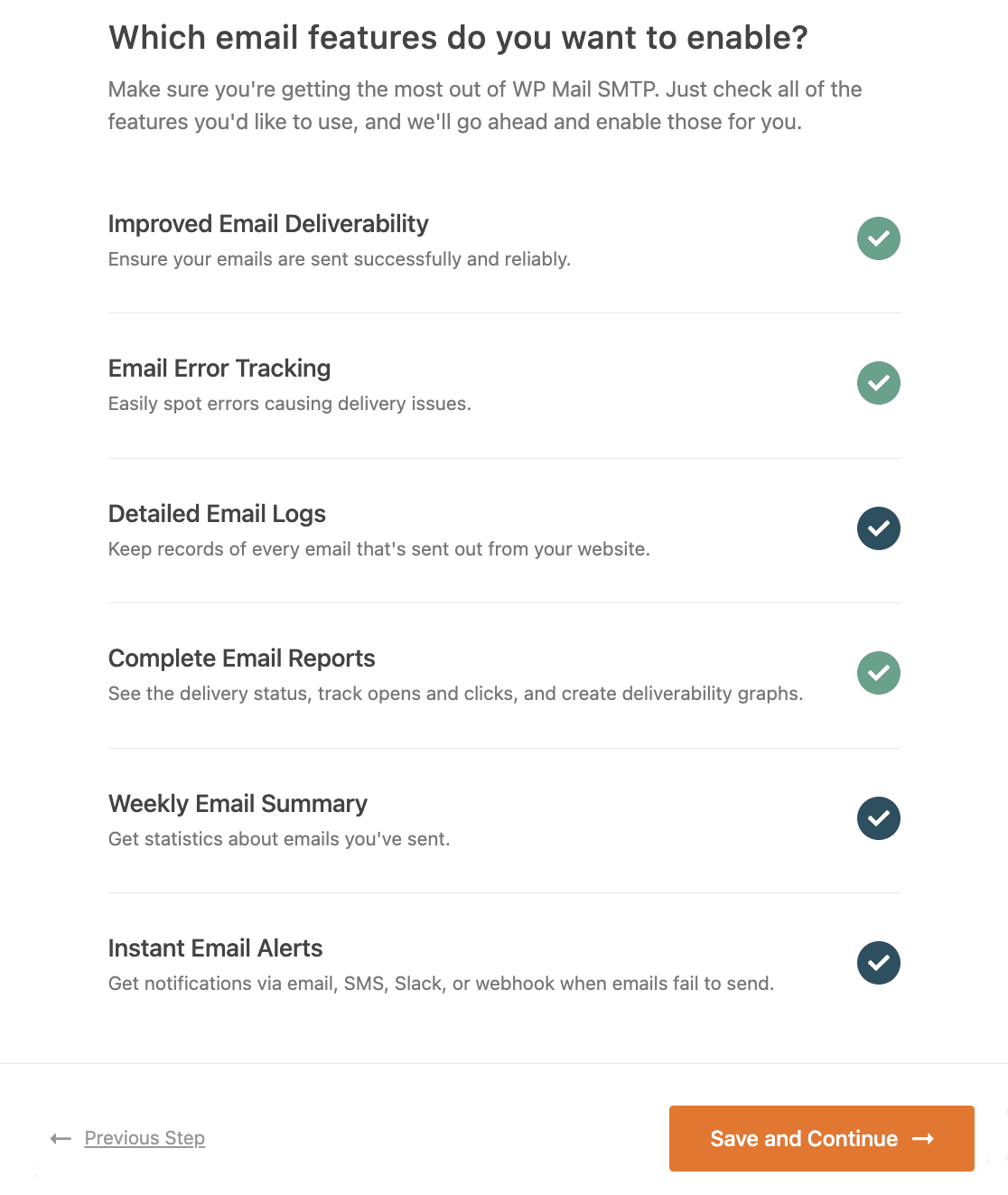
This will automatically turn on Complete Email Reports. You also have the option to receive a Weekly Email Summary of your logs as well as Instant Email Alerts whenever an email fails to send.
Once you’ve enabled the features you want to use, you’ll have the chance to configure some advanced email logging features.
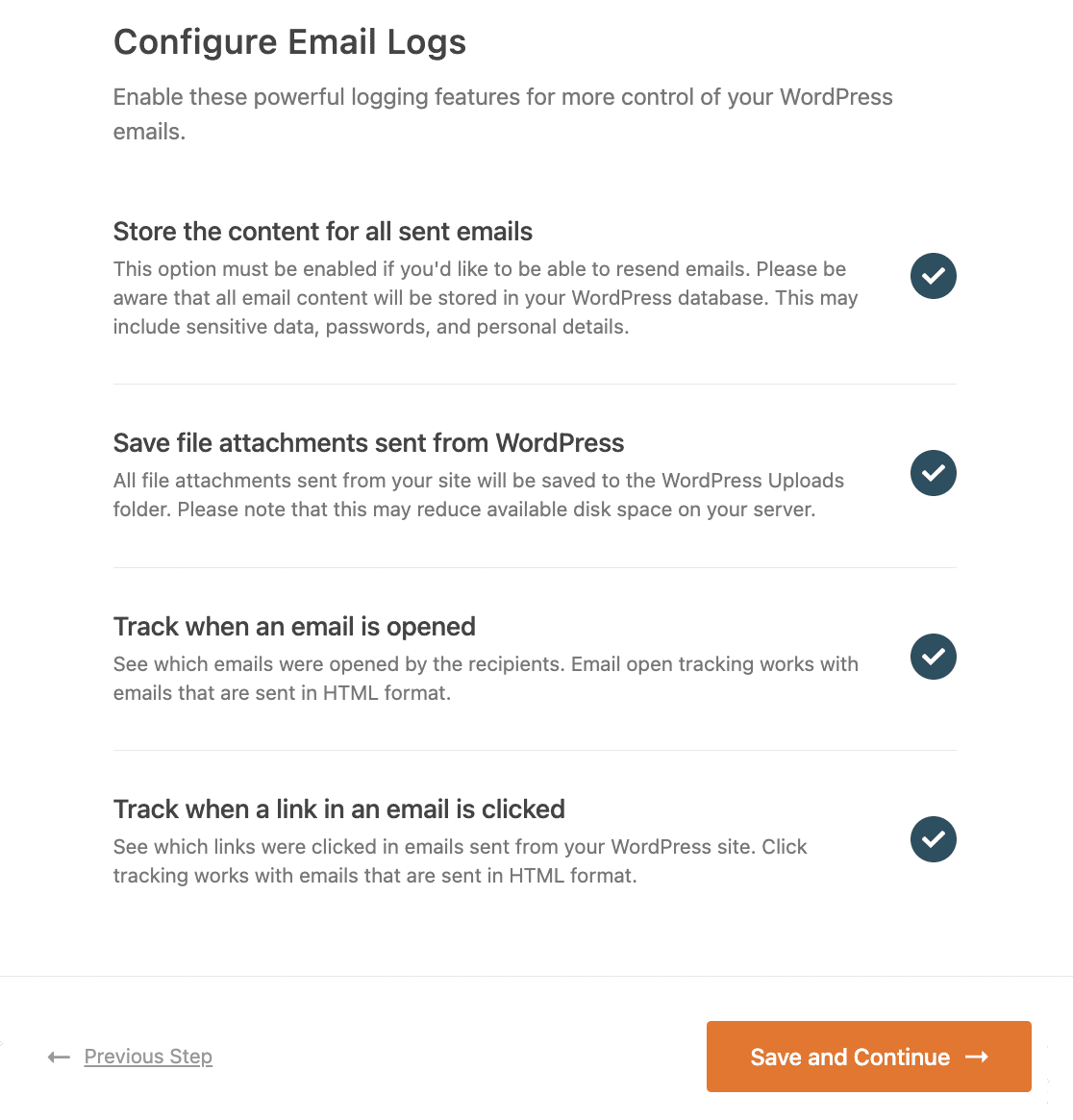
These options include:
- Store the content for all sent emails. Save email content in your site’s database.
- Save file attachments sent from WordPress. Save attachments in your site’s Uploads folder.
- Track when an email is opened. See when recipients open your emails.
- Track when a link in an email is clicked. See when recipients click links in your emails.
Save your settings and move through the Wizard to the final step. If you ever want to change these settings, go to WP Mail SMTP » Settings » Email Log. For more details, check out our post on WP Mail SMTP email logging.
Once you complete the Setup Wizard, you’ll receive an automatic test email to confirm that your new email provider is working.
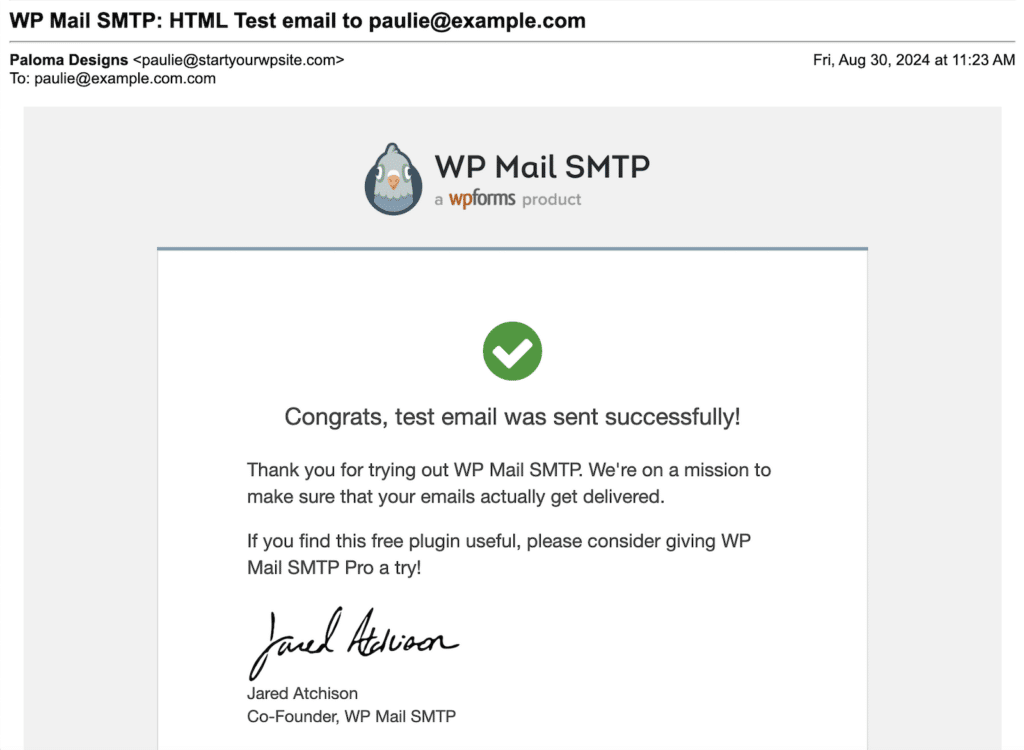
At this point, you’ll want to wait for a few order emails to be generated. If you don’t want to wait, you can go to WP Mail SMTP » Tools » Email Test to send a few test emails from WP Mail SMTP.
Let’s take a look at your new WooCommerce email log to see the new tools you have access to.
2. View Your WooCommerce Email Log
Now we’ve turned on email logging and we’re logging the entire contents of every order email.
Let’s open up WP Mail SMTP » Email Log and take a look at a typical email log from WooCommerce.
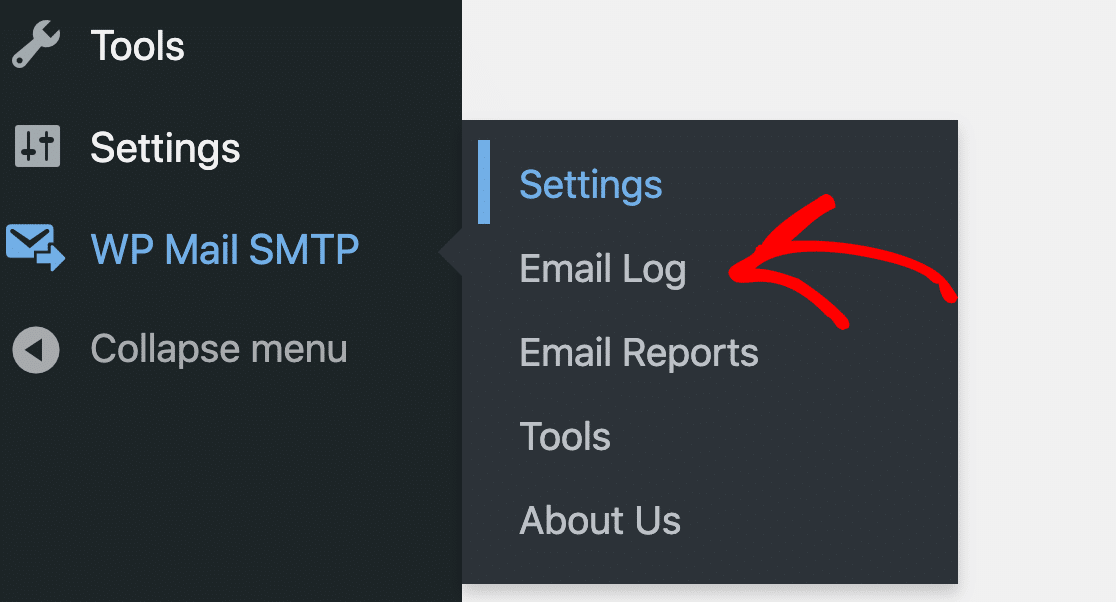
In this example, we have 2 emails that were automatically generated when a customer placed an order.
The Source is WooCommerce which makes it easy to pick them out.
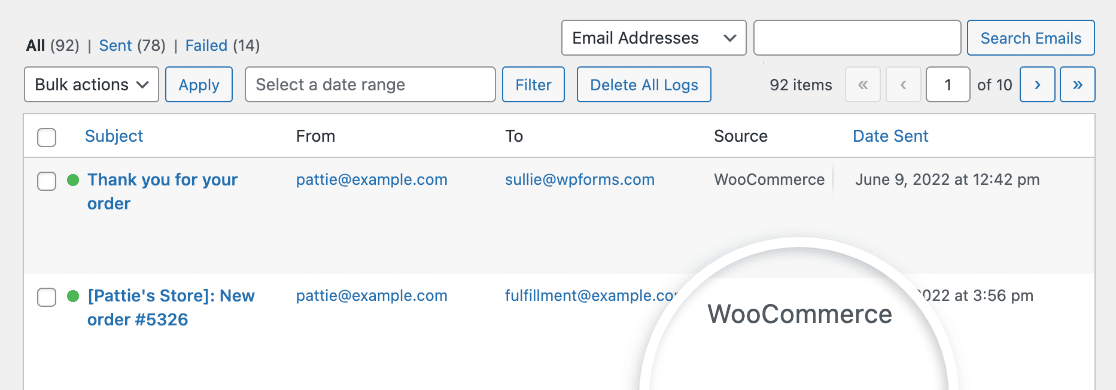
From the email log, we can also see:
- Email subject
- From and To address
- Open and click tracking details
- Date and time sent
Now let’s check out an individual email log to see what else we can do.
Move your mouse over the subject line and click View Log.

Now we can see the log file for this order email in a fullscreen layout.
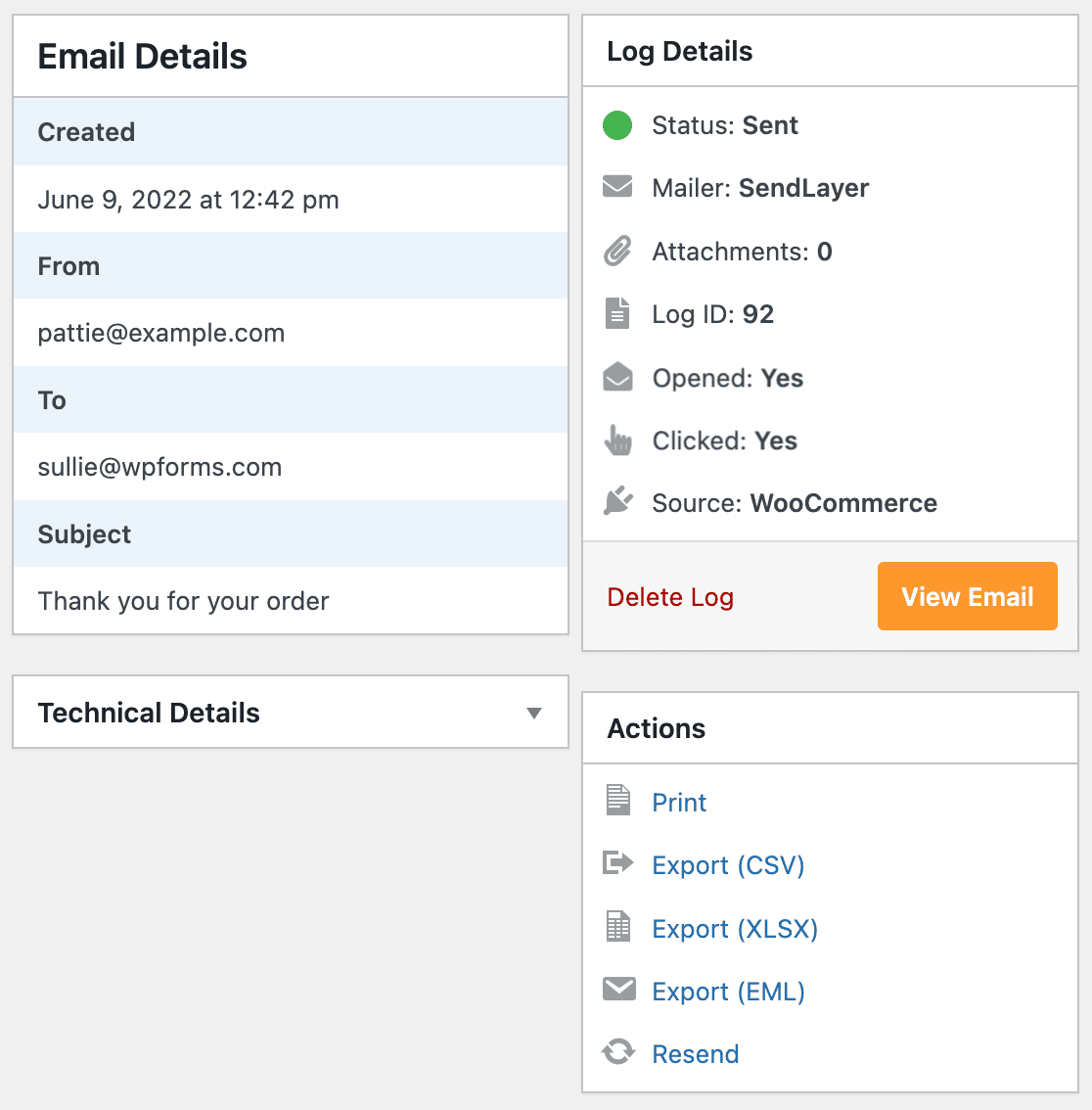
From the email log, you can:
- View the sent email (handy if you’re using a WooCommerce email customizer plugin and you want to check that the layout looks good)
- Print the email log
- Export your email log to CSV or XLSX
- Export the entire email and attachments as an EML file
- Resend the email, which we’ll look at in the next section.
Great! Now you know how to view your WooCommerce email logs. In the final section, we’ll take a closer look at some of the extra tools you can use to manage order emails.
3. Track and Resend WooCommerce Order Emails
Now you’ve fixed WooCommerce not sending emails with WP Mail SMTP, and you’ve also got your WooCommerce email log up and running.
Let’s take a closer look at 2 important features that’ll help you manage order emails.
First, let’s see how to resend order emails that have failed from the email log.
How To Resend WooCommerce Order Emails
From time to time, an email may still fail when it’s sent from WooCommerce, even if you’re using WP Mail SMTP.
For example, your email provider or SMTP server might go offline briefly.
If that happens, you can easily resend WooCommerce order emails from your email log, either individually or in bulk.
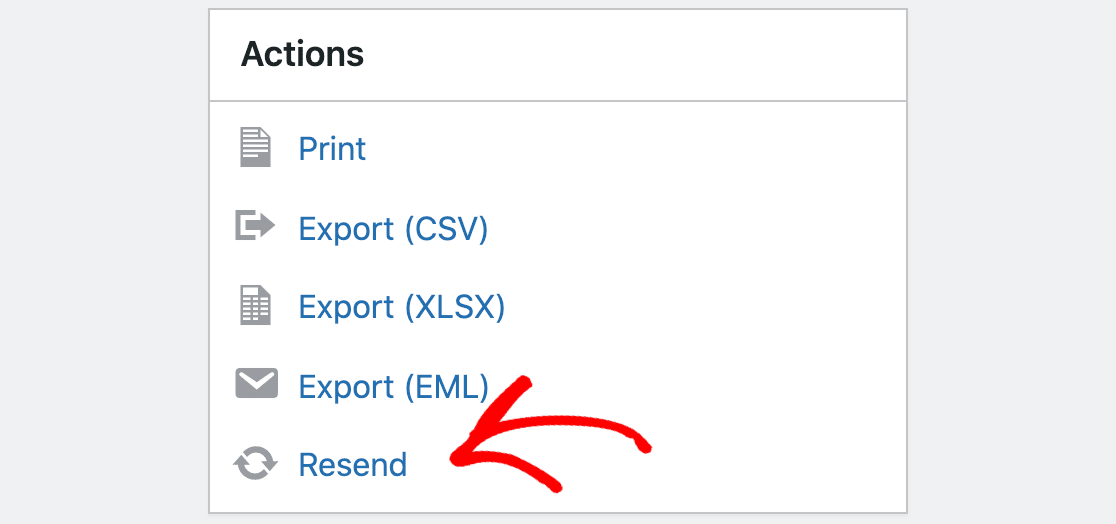
You can also change the recipient address when you resend an email individually.
If you want, you can add multiple addresses separated by commas. This is a great way to resend the order email to an alternative address provided by your customer.
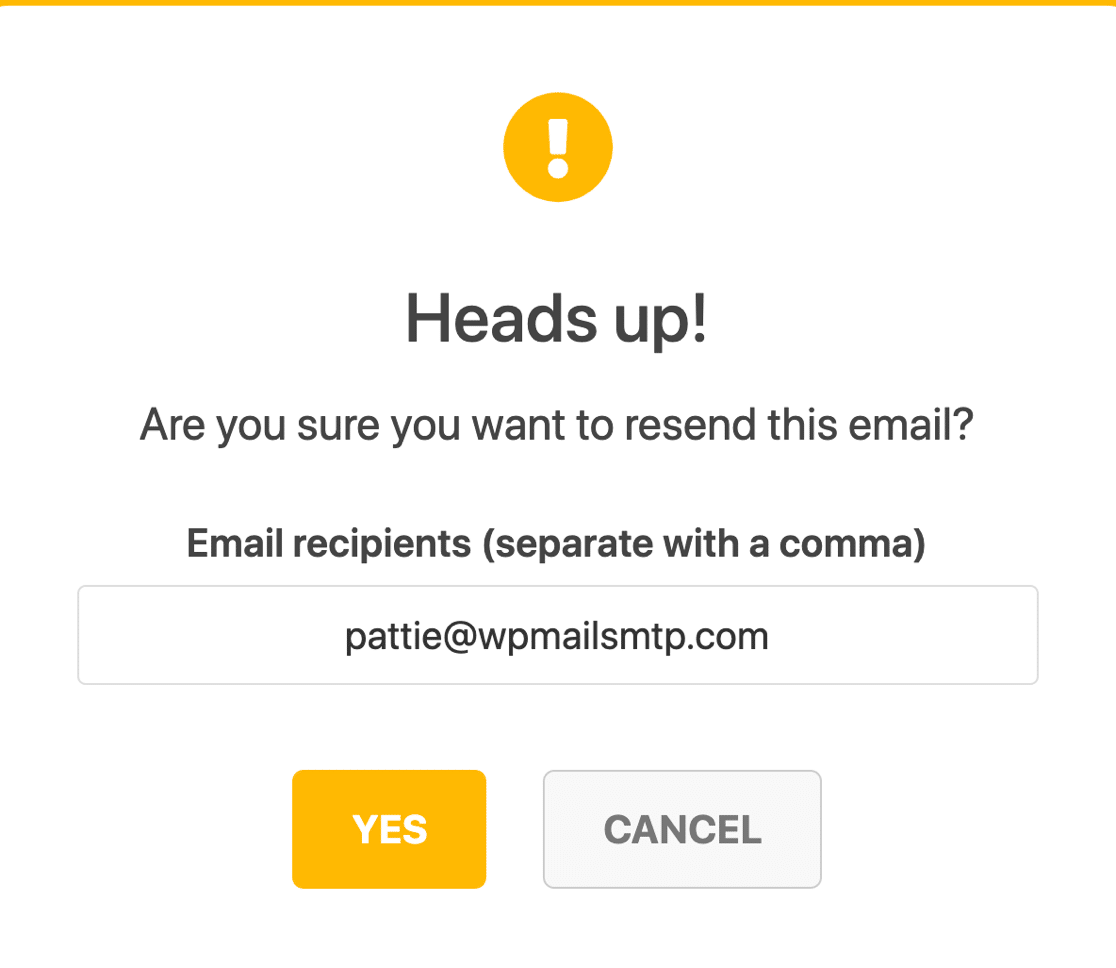
You’ll know when an email fails because it has a red dot next to it in the email log.
If you see a bunch of emails like this, you can check the boxes and use the Bulk actions dropdown to quickly resend all of them at the same time.
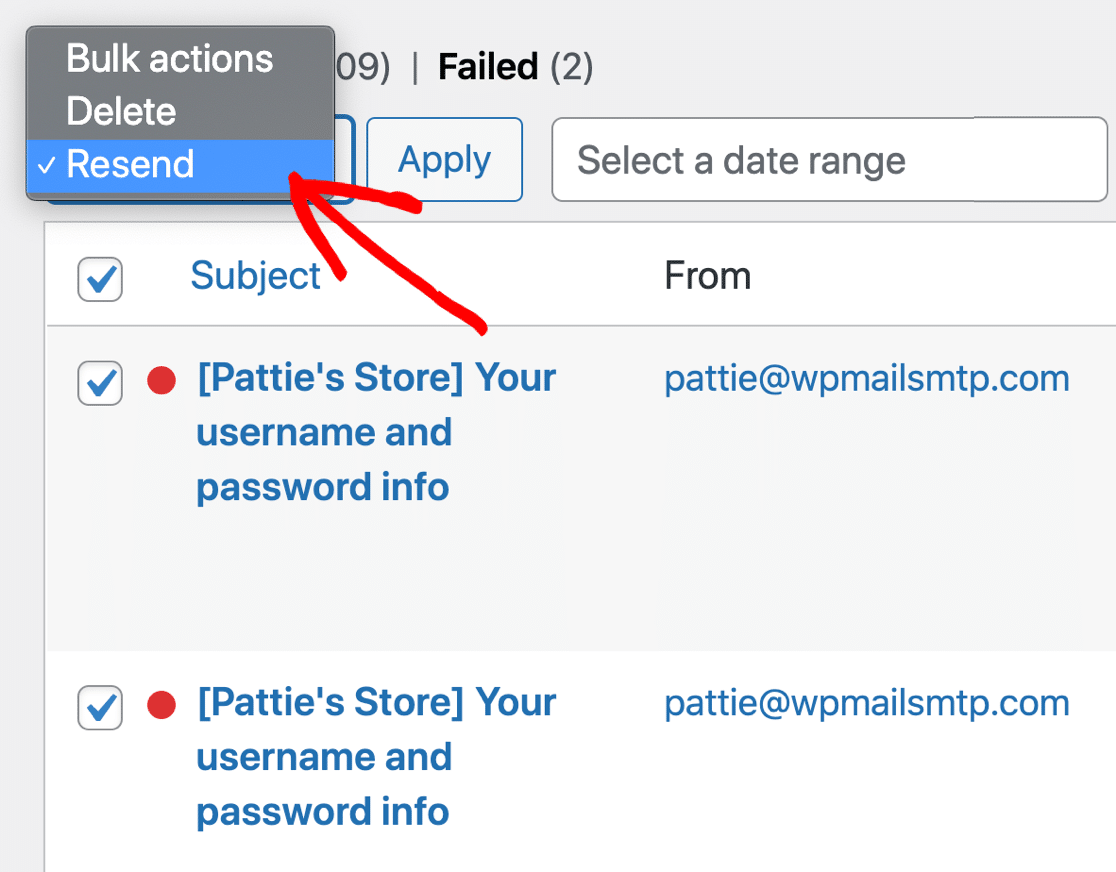
WP Mail SMTP will queue the emails in the background, so this won’t slow down your web server, even if you resend a lot of emails at the same time.
Delivery status tracking is just 1 of the ways you can track WooCommerce order emails. Let’s look at the other 2 in the final section.
How To Track WooCommerce Order Emails
We already looked at delivery status tracking in WP Mail SMTP. Delivery status tracking is enabled as long as you have email logging active.
In addition, you can also track opens and clicks in your emails. This makes WP Mail SMTP an awesome user tracking plugin for WooCommerce stores.
You can see opens and clicks for individual emails or measure performance for a group of emails in your Email Report.
First, let’s go back to WP Mail SMTP » Settings and click the Email Log tab.
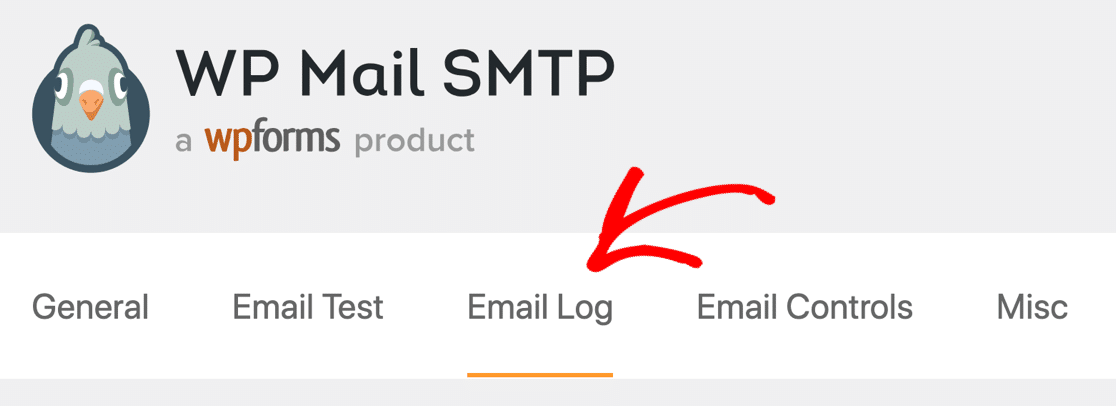
Next, we’re going to enable WooCommerce email tracking. Be sure to check these options:
- Open email tracking
- Click link tracking

Awesome! Now you’ll be able to see how your emails are performing.
First, let’s see open and click-tracking data in your Email Reports.
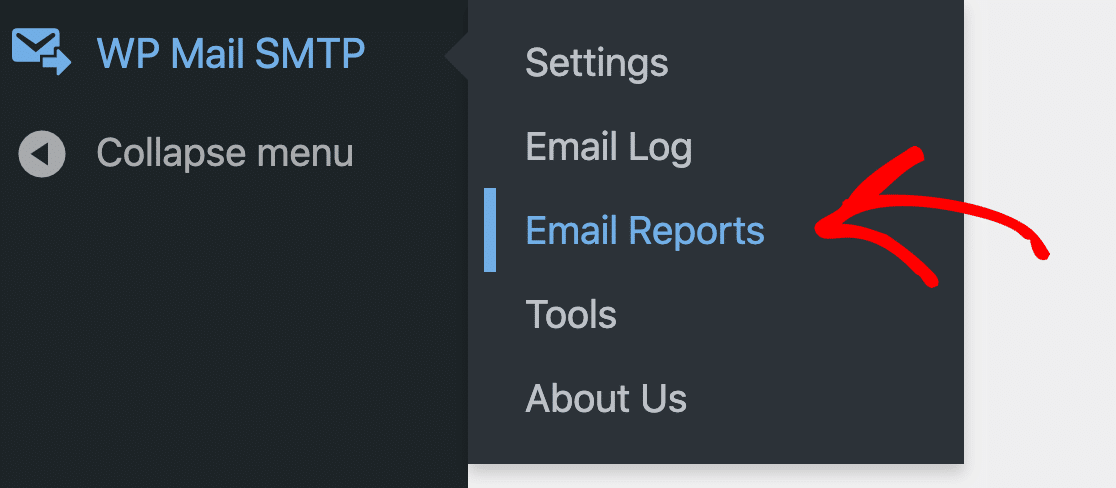
Your email report combines delivery status tracking, open tracking, and click-tracking into 1 chart. You can see a total for all emails or group the chart by subject line.
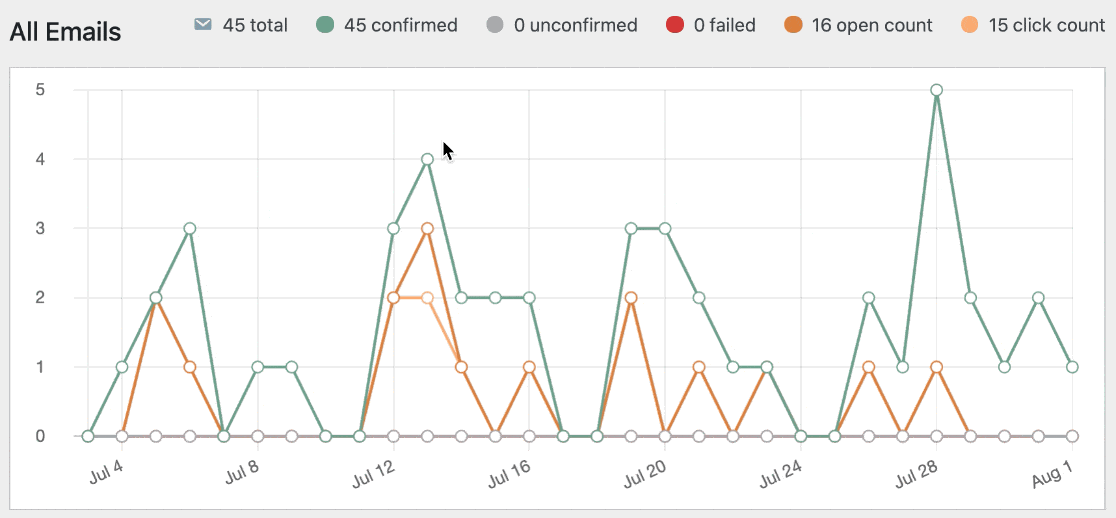
And you can also see open and click tracking for any individual email in your email log.
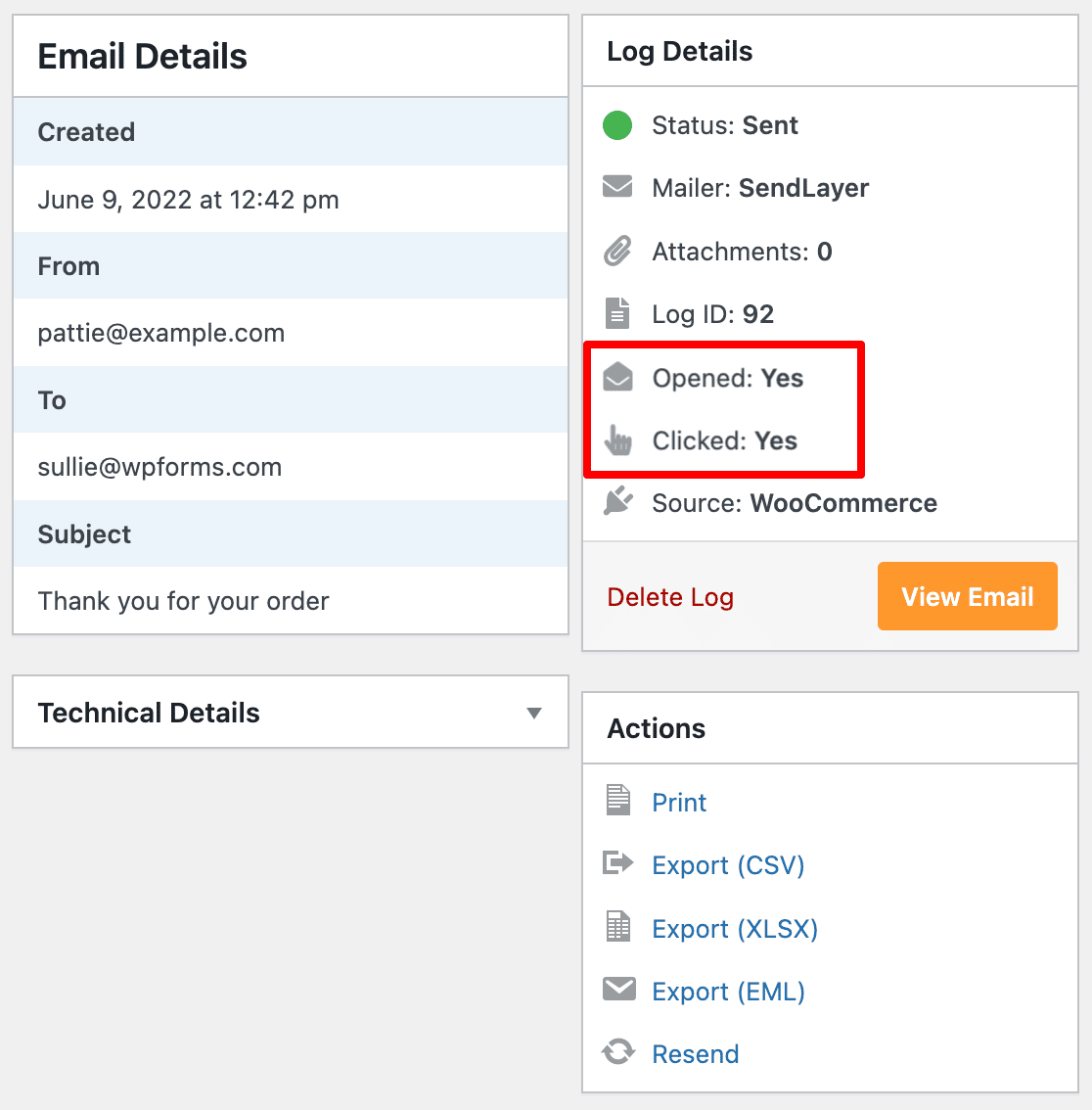
If the customer hasn’t opened the email, you could follow up with them to make sure they received it.
This is a great tool for any emails you send from WordPress because it allows you to track emails from contact form plugins too.
And that’s it! Now you know how to set up your own WooCommerce email log.
Fix Your WooCommerce Emails Now
FAQs About WooCommerce Email Logs
Many of our users ask for help in viewing and making use of their WooCommerce email logs. Here are some of the most common questions our support team receive:
What is a WooCommerce email log?
A WooCommerce email log is a record of all emails sent from your online store, including order confirmations, shipping notifications, and customer account emails. It tracks whether emails were successfully sent, along with details like recipient, subject, timestamp, and delivery status.
Why do I need email logging for WooCommerce?
Email logging helps you verify that important transactional emails are being sent, troubleshoot delivery issues when customers report missing emails, resend failed or lost emails with one click, maintain records for customer service and dispute resolution, and track email performance with open and click rates.
Does WooCommerce have built-in email logging?
No, WooCommerce and WordPress don’t include native email logging functionality. You’ll need a plugin like WP Mail SMTP Pro or similar email logging solutions to track your store’s email activity.
Can I see if customers opened their order emails?
Yes, with WP Mail SMTP Pro’s email tracking features, you can see when customers open emails and click links. This requires enabling open tracking and click tracking in the plugin settings.
What’s the difference between email logging and email tracking?
Email logging records that an email was sent from your server, including basic details like recipient and subject. Email tracking goes further by monitoring if emails were delivered, opened, and whether links were clicked.
Can I export my WooCommerce email logs?
Yes, WP Mail SMTP Pro allows you to export email logs in CSV or XLSX format for reporting, analysis, or compliance purposes. You can also export individual emails as EML files.
Which WooCommerce emails can be logged?
A properly configured email log captures all emails sent through WordPress, including order confirmation emails, processing and completed order notifications, shipping and tracking updates, customer account emails (welcome, password reset), admin notifications, refund and cancellation emails, and any custom WooCommerce emails.
Next, Create a Newsletter For Your Customers
Are you using email to keep your customers up to date? Email is essential if you want to keep customers coming back for repeat purchases.
You can easily build your email list and create newsletters without leaving the WordPress dashboard!
Get started with this guide to the best newsletter plugins for WordPress.
Ready to fix your emails? Get started today with the best WordPress SMTP plugin. If you don’t have the time to fix your emails, you can get full White Glove Setup assistance as an extra purchase, and there’s a 14-day money-back guarantee for all paid plans.
If this article helped you out, please follow us on Facebook and Twitter for more WordPress tips and tutorials.

